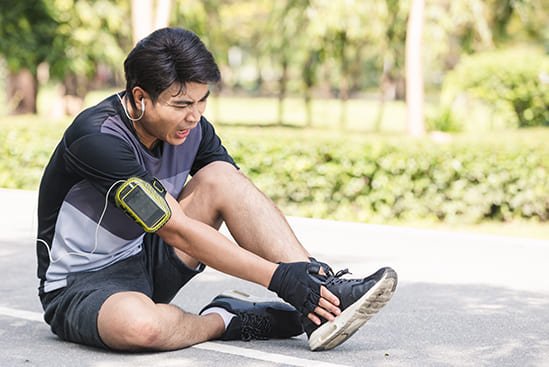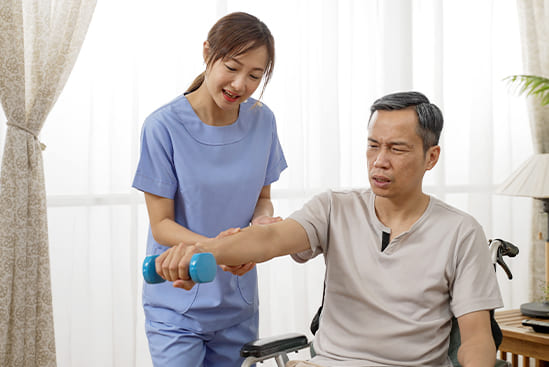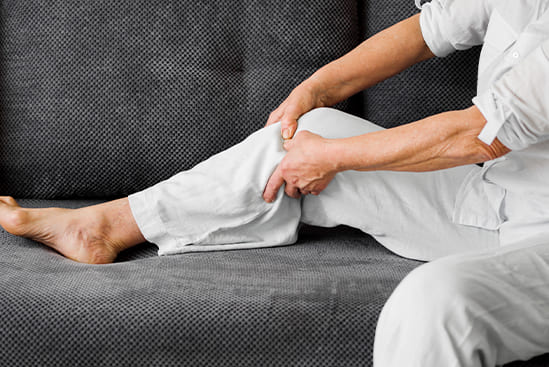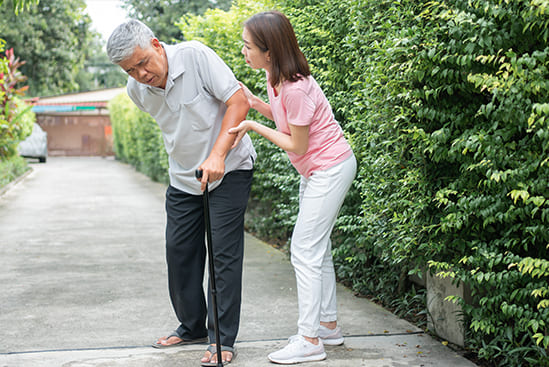
Neurological Conditions, Synapse Physiotherapy
Introduction
Parkinson’s disease (PD) is a progressive neurodegenerative disorder characterised by the degeneration of dopamine-producing neurons in the brain. This results in a range of motor and non-motor symptoms that can significantly impact an individual’s quality of life. Moreover, Parkinson disease patients have an increased risk of falls, even in the early stages, which may have widespread consequences such as fractures, hospitalisation and may even be fatal at times if the fall is severe.
If you are looking for physiotherapy in Malaysia, come on over to Synapse Physiotherapy. Our physiotherapists are well-equipped and trained in treating any neurological diseases such as Parkinson’s disease, stroke and multiple sclerosis.
As the disease progresses, these symptoms result in progressive difficulties in activities of daily living, greater dependence on others and social isolation, while having a significant impact on the quality of life of patients and their families. While there is no cure for Parkinson’s disease, various treatment modalities, including physiotherapy, play a crucial role in managing symptoms and improving daily function by aiming to improve multiple Parkinson disease related impairments, including problems related to physical capacity, inactivity, gait, posture, transfers, balance, and falls.
Understanding Parkinson’s Disease
Parkinson’s disease primarily affects movement, leading to cardinal motor symptoms such as:
– Resting tremors: Involuntary shaking, often starting in the hands.
– Bradykinesia: Slowness of movement during daily activities such as dressing, showering, or moving in bed. Feeling that the feet are frozen to the floor, making it hard to take a first step or to turn around when walking.
– Muscle Rigidity: Stiffness and inflexibility of the muscles, causing pain and discomfort in the neck, trunk, or shoulders.
– Postural Instability: An unstable stooped posture, resulting in impaired balance and coordination, leading to a greater risk of falls.
Some other symptoms include:
– Altered walking pattern, including freezing of gait
– Difficulty speaking at a normal voice level
– Trouble swallowing, increasing risk of choking
– Difficulty making facial expressions, often portrayed as having a mask face
– Difficulty holding and releasing urine (bladder urgency and incontinence).
Non-motor symptoms can include cognitive changes, mood disorders, fatigue, lightheadedness, sleep disturbances, and autonomic dysfunctions.
The Role of Physiotherapy in Parkinson’s Disease
Physiotherapy assessment and management focuses on improving physical capacity and quality of movement in daily life through walking, transfer training, balance and falls education, and practice of manual activities such as reaching and grasping. This makes physiotherapy an essential component of comprehensive care for individuals with Parkinson’s disease.
During the earlier stages of Parkinson’s disease, your physiotherapists will emphasise on education and self-management like going for programmes that promote general fitness and inclusion in community activity. Physiotherapy specific exercise is proven to offset the effects of Parkinson’s and to minimise deterioration in strength, endurance, flexibility and balance.
As the condition progresses, physiotherapists will teach and apply movement strategies to overcome challenges in generating automatic movement and thought, including strategies to compensate for loss of function, using external cues like auditory, tactile, visual and sensory as well as internal cues be it mental rehearsal or visualisation. Physiotherapy can also greatly help with dual task training, self-instruction and improving attention span.
The goals of physiotherapy for Parkinson’s patients include:
– Improving mobility and flexibility
– Enhancing balance and coordination
– Increasing strength and endurance
– Reducing pain and discomfort
– Promoting independence in daily activities
Key Physiotherapy Interventions
- Exercise Therapy
Regular exercise is vital for maintaining physical health and mitigating the symptoms of Parkinson’s disease. Exercise therapy includes:
– Aerobic Exercise: Activities like walking, cycling, and swimming improve cardiovascular health and overall endurance.
– Strength Training: Resistance exercises targeting major muscle groups help maintain muscle mass and strength.
– Flexibility Exercises: Stretching routines enhance flexibility and reduce muscle stiffness.
– Balance and Coordination Training: Exercises such as standing on one leg, using balance boards, and practising Tai Chi improve stability and reduce the risk of falls.
2. Gait Training
Parkinson’s disease often affects the way individuals walk, leading to shuffling steps, reduced arm swing, and difficulty initiating movement. Gait training focuses on:
– Improving Stride Length and Speed: Techniques to encourage longer, more deliberate steps.
– Enhancing Arm Swing: Promoting coordinated arm movements to assist with balance.
– Cueing Strategies: Using auditory (metronome beats) or visual cues (floor markers) to help initiate and maintain walking patterns.
3. Postural Training
Postural instability is a common issue in Parkinson’s disease, leading to a stooped posture and increased fall risk. Postural training includes:
– Exercises to Strengthen Core Muscles: Core stability exercises enhance trunk control and posture.
– Stretching and Strengthening: Targeting muscles of the back and shoulders to correct stooped posture.
– Postural Awareness: Techniques to increase awareness of body alignment and promote upright posture.
4. Functional Training
Functional training aims to improve the ability to perform daily activities and maintain independence. This involves:
– Task-Specific Training: Practising activities such as rising from a chair, turning, and reaching.
– Adaptive Techniques: Teaching methods to modify movements for greater ease and safety.
– Use of Assistive Devices: Recommending and training in the use of canes, walkers, or other devices to enhance mobility.
5. Respiratory Training
Respiratory complications can arise in Parkinson’s disease, leading to reduced lung function and respiratory muscle weakness. Respiratory training includes:
– Breathing Exercises: Techniques to improve lung capacity and efficiency.
– Strengthening Respiratory Muscles: Exercises like diaphragmatic breathing and using resistance devices.
6. Education and Support
Physiotherapists play a crucial role in educating patients and their caregivers about Parkinson’s disease, exercise benefits, and safety precautions. Providing emotional support and encouragement is also vital in maintaining motivation and adherence to therapy.
Emerging Techniques and Research
Ongoing research in physiotherapy for Parkinson’s disease is exploring innovative techniques and technologies:
– Virtual Reality (VR) Training: VR-based exercises offer engaging and immersive ways to practise movements and improve balance.
– Robotics and Exoskeletons: Assistive robotic devices can enhance strength training and mobility exercises.
– Dance Therapy: Dance, particularly styles emphasising rhythm and coordination, has shown promise in improving motor function and quality of life.
Conclusion
Physiotherapy is a vital component in the management of Parkinson’s disease, offering a range of interventions to address motor and non-motor symptoms. Through tailored exercise programs, gait and postural training, functional training, and respiratory exercises, physiotherapists help individuals with Parkinson’s maintain mobility, independence, and quality of life. As research continues to advance, new techniques and technologies hold promise for further enhancing the effectiveness of physiotherapy in this population.
Tags :

Back & Neck Pain
Conditions such as stiffness, postural abnormalities and muscle overuse from prolonged desk work at the office or home is more prevalent than most would think. We provide the necessary tools to fix you up and educate you on ergonomics which can unload unnecessary stress.
- Spine & Core Rehabilitation
- Strength & Conditioning Programme
- Pain Management
- Biomechanical Assessment
- Sports Physiotherapy
- Group Class

Sports Injuries
Rolled ankles, jarred knees, impinged shoulders are few conditions in the plethora of sports injuries which can hamper performance and limit our enjoyment of sports. Physiotherapy not only treats the symptoms of these conditions but propels your overall fitness to greater heights.
- Strength & Conditioning Programme
- Pain Management
- Biomechanical Assessment
- Sports Physiotherapy
- Shockwave Therapy
- Group Class

Work Desk Injuries
Conditions such as stiffness, postural abnormalities and muscle overuse from prolonged desk work at the office or home is more prevalent than most would think. We provide the necessary tools to fix you up and educate you on ergonomics which can unload unnecessary stress.

Pre-Post-Surgical Conditions
Surgery involves going through preparation both before and after. Physiotherapists play a vital role in getting your body ready for surgeries with circulatory, breathing and strengthening exercises. After the procedure, let us be there for your recovery and rehabilitation, taking it one step at a time.

Scoliosis & Postural Abnormalities
The way we stand, sit, walk and sleep has influence over our posture and the overall balance of muscles controlling its alignment. A comprehensive screening can be done by our physiotherapists to detect abnormalities, which we will aid in correcting.

Neurological Conditions
Neurological disabilities such as stroke, nerve compression and neuropathies can be barriers for patients to live life to its fullest. We at Synapse are committed to help you overcome these hurdles by ensuring functional mobility and quality of life is at its optimum by providing the right treatment and exercises.

Osteoarthritis & Rheumatism
Joint degeneration and inflammation happens as the human body grows older, but that does not mean our way of life degenerates as well. Relief your joint pains with a joint effort together with your physiotherapist, who will provide pain-relief treatments and prescribe exercises for your wellbeing.

Conditions Relating To Elderly
Common conditions in the older age population include hips & knee pain, back & neck pain, osteoarthritis, rheumatism, fear of falling and many more. Aging and degeneration of bodily function is inevitable, but here at Synapse, we will help you live the best of your life.

Home Physiotherapy
We understand that some conditions or injuries can make it difficult to receive rehabilitation at our clinic be it mobility or transportation issues. Our objective is to provide you with the same high-quality physiotherapy services at home that you would receive in-clinic.
